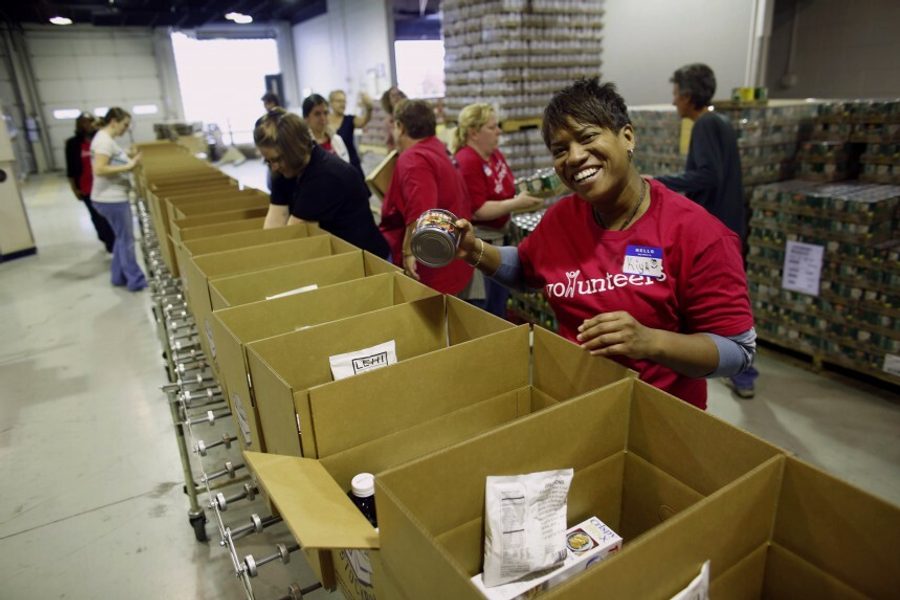
Last August, on the first day of an eight state, two-installment RV tour to address poverty and prosperity in rural America for the upcoming farm bill, U.S. Department of Agriculture Secretary George “Sonny” Perdue visited the Wisconsin State Fair.
Activities that morning included carnival rides and a listening session with farmers, which Perdue hosted alongside Wisconsin Gov. Scott Walker. Afterward, Perdue, Walker and their families were in search of food. Walker quipped, “We’ll probably find a few things on a stick.”
Perdue then set out in a Class A Hurricane Thor Motor Coach (floorplans start with an MSRP value above $100,000) to meet with young farmers at a farm he called, “a feed the hunger” type farm — in reference to the Hunger Task Force Farm south of Milwaukee. Perdue also hosted Paul Ryan in the RV later that day. They sat around a thumbnail kitchen table beneath a blank, wall-mounted LED television, before hosting a speaking event.
Dubbed the “Back to Our Roots” tour, Perdue vowed that the “USDA will be intimately involved” with Congress in writing the next farm bill, and that the tour would put him out “on the front lines of American agriculture” and enable him to “know best what the current issues are.”
His quest culminated in late January in Mifflingtown, Penn., where he presented the USDA’s “2018 Farm Bill & Legislative Principles” to Pennsylvania Farm Bureau members at Reinford Farms. Perdue described the four-page document as the “roadmap” to the USDA’s farm bill priorities.
The report comes as Congress has begun deliberations for the next farm bill — what could be one of the largest non-defense funding authorizations in our nation’s history. The current bill expires on September 30, and the House Ag committee could take its first votes on a new bill any day now.
The farm bill structures almost everything that governs our food system. It dictates incentives as to what is grown and what we eat. It establishes farm subsidies and trade policy. It regulates crop insurance, nutrition programs, forestry polices and conservation programs. It allocates funds for disaster relief and food assistance programs. Farm bills are passed by Congress about every four or five years.
But what began as a strategy to restore farm purchasing power has become infamous for its history of political drama and logrolling spectacle; a chimeric piece of legislation over which a dizzying array of interests vie for their stake. Lurking behind a name that connotes pastoral innocence, lies a knotted entanglement of Congresspeople serving the interests of Big Ag and corporate lobbyists. Some experts have even decried the bill as a public health crisis.
“No one person has a handle over the entire bill. They can’t possibly do that,” says Marion Nestle, former professor of Nutrition, Food Studies, and Public Health at New York University. “Everybody knows what a farm bill ought to do. But power politics gets involved. There were hundreds of amendments put forth for the last one. Nobody can possibly know the issues involved in them. So, it’s who pushes the hardest.”
Nestle recalls how one staff member from the Senate Agricultural Committee met with an NYU class she taught on the farm bill. The staffer admitted to the class that after eight years working with the committee, her best resources for learning what was in the bill were lobbyists.
“[Senate Agriculture Committee staff] would meet with lobbyists and lobbyists would explain what the programs were about and what they wanted, and that’s how she learned it,” Nestle says. In 2014, the farm bill was the sixth most lobbied piece of legislation that year.
Since the tumultuous passage of the last farm bill in 2014 (it was passed two years after the previous farm bill expired), farmers have been experiencing an economic upheaval similar to that of the 1980s.
In May 2017, the National Farmers Union launched a website to address a four-year prolonged farm crisis, replete with information on disaster relief for the year’s weather catastrophes, how to apply for emergency relief loans, and a suicide prevention hotline. (A 2016 study by the Centers for Disease Control found that that people working in agriculture — including farmers, farm laborers, ranchers, fishers, and lumber harvesters — take their lives at a higher rate than any other occupation.)
According to Jennifer Fahy, communications director for the nonprofit organization Farm Aid, in 2017 chapter 12 bankruptcies — farm bankruptcies — increased at a faster rate than any other type of bankruptcy. Fahy says the Farm Aid has been receiving a record number of calls in recent years. In 2017, Farm Aid tripled the number of emergency grants made to farmers, and in 2018 they’re on track to triple that number again. “Land rents are up and expenses are up and [farmers’] margins are smaller and smaller,” she says. “These are people who have built their lives around their farms. When a farm goes under, it’s not just the business that goes under; it’s the loss of the farm and the land, and usually the family’s home.”
The USDA estimates that from 2009 to 2016, about 109,660 farms have disappeared, with small and midsized farms bearing the brunt of these closures. Over the past four years, net farm income has declined by an estimated 50 percent, marking the largest drop since the Great Depression. Commodity prices have taken a nosedive across the industry, with significant losses to corn, wheat, soybean, and dairy prices dipping below their post-2008-recession levels.
To address the crisis, Perdue has commandeered rhetoric of his predecessor Henry A. Wallace, Roosevelt’s agriculture secretary. Perdue chairs the Interagency Task Force on Agriculture and Rural Prosperity, which was established by Trump in 2017, and he’s donned a new mantra for the USDA: “Do Right and Feed Everyone.”
The first farm bill, passed in 1933, in many ways embodied Wallace’s New Deal vision. In the years leading to the Great Depression, many farm journals and farm organizations had warned farmers to control production, as ready markets and fair prices were shrinking or not available. When the economy crashed, farmers were struck swiftly and directly. As prices for commodities plummeted, farmers faced a surplus of production because many U.S. families were too poor to buy food. Wallace pledged that the government would buy “from those who have too much to give to those who have too little.” The Agricultural Adjustment Act of 1933 was established by Congress’ to “relieve the existing National Economic Emergency by increasing agricultural purchasing power.” It was the first major New Deal agricultural legislation, and was declared unconstitutional by the U.S. Supreme Court in 1936.
For farmers and farm advocates, Perdue’s rhetoric has so far shown to be full of empty promises, raising great concerns with how the farm bill will proceed. Perdue has helmed something of a skeleton crew at the USDA, which is undergoing major organizational restructurings (he eliminated the Rural Development Mission Area), staff vacancies and scandal. It was not until January — long after farm bill discussions had begun — that the USDA appointed an official congressional liaison. As of April 12, only six of the 13 USDA positions that require Senate confirmation have been confirmed. Three are pending and the other four have no nominee.
Farmers and farmer advocates say such administrative uncertainty and negligence has resulted in delays and impaired access for essential services during the Spring planting season, and have raised concerns about how committed the USDA will be to small farmers through the stifling political process of the farm bill.
“The language from the administration on issues like trade and immigration have been really challenging because they’re creating this climate of uncertainty that’s impacting farmers,” says Fahy of Farm Aid. “There’s language out there that rural America is important and that the administration is going to do the right thing, but the details are missing. We have farmers calling because they can’t get access to the credit they need for the operating loans to put seeds in the ground for this spring.”
In the months since Secretary Perdue’s visit to the Hunger Task Force Farm, Sherrie Tussler, executive director of the Hunger Task Force, has likewise noted a significant shift in her group’s relationship with the USDA.
“There seems to be a chilling effect, frankly, on the work that we’ve done together previously of improving the quality of the federal nutrition programs and their access at a local level,” says Tussler.
For Tussler, Perdue’s visit to Wisconsin may have signaled the USDA’s legislative agenda to come. When asked about food assistance programs during his trip, Perdue said at the time, “Everybody can get down on their luck. We understand that. We understand compassion is needed. But that should not be a lifestyle of dependency on the government for food.”
Tussler was recently surprised to see her photo with Perdue in the 2018 report next to the section calling for strengthening work requirements for SNAP (Supplemental Nutrition Assistance Program) recipients. “I’m holding up commodities because I’m showing him what kind of foods low-income people live on,” Tussler says. “He was not terribly impressed with the powdered milk,” which is one of the commodity products seniors receive through the USDA’s Commodity Supplemental Foods Program. “We’re at the farm, but I’m showing him commodities.”
Tussler, who has been with the Hunger Task Force for 20 years, sees what has been happening in Wisconsin as foreshadowing what Congress might do with the farm bill with its largest Republican majority in Congress since 1929.
A bureaucracy that benefits the rich at the expense of the poor
In 2015, Wisconsin extended work requirements for able-bodied adults without dependents throughout the state, requiring 80 hours of unpaid work experience a month for enrollees in order to receive FoodShare benefits — the state’s version of SNAP. As a result, Tussler says, people are required to work more than 100 hours in unpaid labor to receive an average of $105 in food assistance benefits per month. ResCare, a for-profit agency in Milwaukee that provides such employability programs for FoodShare recipients, found that only 7 percent gained employment, while 53 percent lost their benefits and were banned from the FoodShare program for three years.
As a part of Governor Walker’s plan to root out fraud in food assistance programs, he also established an Office of the Inspector General in Wisconsin. According to Tussler, recent memos internal to the OIG’s welfare office in Milwaukee — the state’s largest welfare office — report that each new case being opened was required to be marked as potential fraud.
“We don’t really have a fraud problem,” Tussler says, citing Wisconsin as having one of the lowest error rates in food assistance benefits, at 2.5 percent compared with the national average of 3.6 percent. “It just shows a complete lack of understanding for how people live on food stamps.”
The crusade by conservatives to reign in anti-poverty and anti-hunger programs was poignantly on display last February when Perdue pitched the idea of supplementing SNAP with “Harvest Boxes.” As part of the Trump administration’s goal to slash food assistance programs by $214 billion over the next 10 years, the boxes would include “shelf-stable,” low nutrition industrialized calories — in essence the same powdered milk that made Perdue cringe at the Hunger Task Force Farm.
Yet, what received little coverage in the media was not the proposal’s blatant inability to provide healthy food, but rather the fact it’s already been normalized. Since 1977, the USDA’s Food Distribution Program on Indian Reservations—designed as an alternative to SNAP — has been distributing shelf-stable processed food commodities, like apple sauce that contains no apples, to low-income Native Americans. The program has been infamous for perpetuating the “thrifty gene theory” — the notion that falsely puts forth a biological reason as to why American Indians and Alaska Natives have a higher rate of obesity than whites and are far more likely to have Type 2 diabetes.
The effect of imposing this diet of processed food on Native communities has given rise to the phenomenon: “commod bod.” As one University of Oklahoma researcher told NPR, “It makes you look a certain way when you eat these foods.” It has also done little to reduce the prevalence of hunger and poverty. Today 60 percent of Native Americans living on reservations who receive food assistance through SNAP rely on the program as their primary source of food.
Efforts to block-grant the SNAP program have been proposed by House Republicans in the past — a measure Paul Ryan has championed for years, and one that has already been implemented in Puerto Rico with disastrous effect. Such measures would eliminate the program’s entitlement structure, cap spending, cut benefits and increase competition between communities for the program’s resources.
Changing work requirements for SNAP eligibility would target low-income Americans already struggling to provide for themselves and their families. In 2015, nearly half of all SNAP participants (44 percent) were under age 18, while 11 percent were over the age of 60 and 10 percent were disabled nonelderly adults. Furthermore, most SNAP households already held earnings, and a majority of households did not receive cash welfare benefits. Nearly half of all SNAP participants (42 percent) held income at or below the poverty, and more than half (55 percent) of households with children already held jobs. According to the USDA, during the past 25 years, the primary form of income among SNAP participants has shifted from welfare to work. In that time, the number of SNAP households with zero net income rose more than two-fold.
“We are going to reach a point where people are not only living as a sub-class in poverty constantly, but we’re going to put them at risk of not even being able to eat regularly,” says Tussler.
Writing a bill “in secret” that puts commodities and corporations first
As of mid-February, the House version of the farm bill had been drafted, but the draft had not been made public. “There is a bill out there that is supposedly being scored by the Congressional Budget Office, but nobody’s seen it,” said Congressman Jim McGovern (D-Mass.) at a public forum in Massachusetts. According to McGovern, the bill was “being written in secret,” bypassing the traditional subcommittee structure.
Yet as the process wore on, initial rhetoric within the House Agricultural Committee of gaining a needed a bipartisan consensus had dissolved. In March, Reps. David Scott (D- GA) and Jim Costa (D-CA) sent a letter to ranking Democratic Ag committee member Rep, Collin Peterson (Calif.) asking that he abstain from all farm bill negotiations until Conaway agreed to share part of the drafted legislative text. “At no point during the Committee’s 23 hearings on SNAP was there testimony in favor of radical reforms to SNAP,” Scott and Costa wrote.
By early April, House Ag Committee Chairman Mike Conaway (R-Texas) made the pledge of “going forward” with the farm bill in order to defend SNAP eligibility changes. On April 12, the House Ag Committee released the first draft of their bill. With mounting opposition from House Democrats, along with pressure to pass a farm bill with a Republican majority before mid-term elections this year, the new draft faces the chance of a paralyzing death on the House floor.
The drafted bill would increase the age limit of able-bodied working adults from 49 to 59, and would require individuals to work or be enrolled in a job-training program for at least 20 hours a week beginning in fiscal year 2021. By 2026, that minimum number would jump to 25 hours per week. Those who violate the work requirements could become ineligible for SNAP benefits for a 12-month period. Those who fail to meet the requirements a second time would be subject to three years of lost benefits, “unless an individual obtains employment sufficient to meet the hourly requirement or is no longer subject to the work requirements at an earlier time.” Such changes could make as many as 5 to 7 million SNAP recipients subject to stricter work requirements.
And as presaged by Wisconsin’s FoodShare program, the bill seeks to expand a nation-wide crackdown on purported fraud. For instance, state agencies would be allowed to use retained SNAP funds to carry out “actions to prevent fraud,” while also promoting public-private partnerships,paving the way to implement programs such as ResCare and Wisconsin’s FoodShare nationally. It would also expand the Duplicative Enrollment Database in order to “prevent Supplemental Nutrition Assistance Program participants from receiving duplicative benefits in multiple states.”
According to a statement, Conaway said, “The farm bill also keeps faith with these families by not only maintaining SNAP benefits but by offering SNAP beneficiaries a springboard out of poverty to a good paying job, and opportunity for a better way of life for themselves and their families.”
In addition to opposition from Democrats over cuts to food assistance, Conaway faces a divided Republican Party when it comes to crop insurance, with some of the more conservative and libertarian wings of the party (as represented by the Heritage Foundation) also in support of cutting crop insurance. Paul Ryan himself claimed in 2013 that crop insurance was evidence of “crony capitalism.”
“The interests of the commodity producers and the corporations outweigh the interests of low-income people, and as a result we don’t end up assuring the dietary guidelines for Americans,” says Tussler.
“People are supposed to get fruits and vegetables to be half their plate, but we don’t get fruit and vegetables as half our supply,” she says. “The process by which [fruits and vegetables] are offered and the frequency [of which they are provided] really has nothing to do with the needs of low-income people and everything to do with excesses the agricultural market and the politics of the people on the Ag Committee.”
“People can’t just eat canned green beans every single night for dinner,” says Tussler. That is one of the reasons the Hunger Task Force established its own farm to supplement the food and emergency assistance it receives. “We’re a farm ourselves,” says Tussler. “That’s a damn hard life.”






